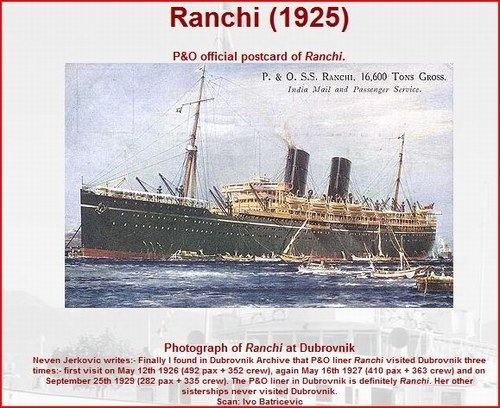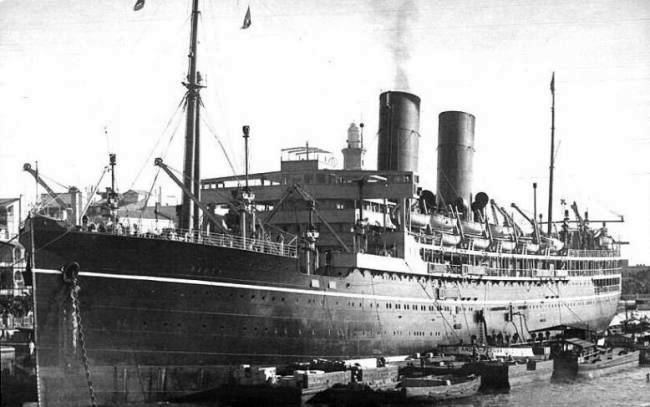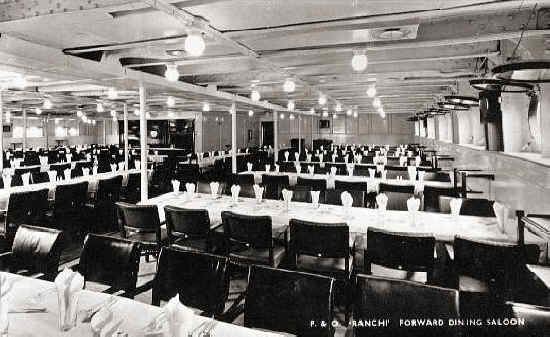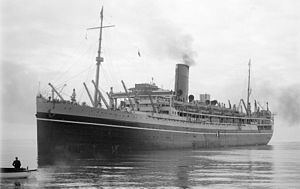Acquired August 1939 Decommissioned July 1947 Reclassified Armed merchant cruiser Length 167 m | Commissioned 23 October 1939 Out of service 16 March 1943 Launched 24 January 1925 | |
 | ||
Builder Hawthorn Leslie and Company Newcastle upon Tyne | ||
The SS Ranchi was a British passenger and cargo carrying ocean liner. During World War II she served as an armed merchant cruiser HMS Ranchi.
Contents
P&O career

The SS Ranchi was built for the Peninsular & Oriental Steam Navigation Company (P&O) by Hawthorn Leslie & Co. at Newcastle Upon Tyne, England and was launched on 24 January 1925. Her gross registered tonnage was 16,650, her length was 547 feet and her beam 71 feet. She was one of the P&O 'R' class liners from 1925 that had much of their interiors designed by Lord Inchcape's daughter Elsie Mackay.

Named after Ranchi, the capital city of Jharkhand state in eastern India, she sailed on a regular route between England and Bombay, India. Later she sailed to the Far East. She carried 600 passengers.
Second World War

The SS Ranchi was requisitioned into the Royal Navy on 27 August 1939 (at the onset of World War II) and commissioned on 23 October 1939 as the armed merchant cruiser HMS Ranchi (Pennant F15). As an armed merchant cruiser, her gross registered tonnage was 16,738.

Her sister ships SS Rawalpindi, SS Rajputana and SS Ranpura were also converted to armed merchant cruisers. Except for small corvettes, the converted passenger ships like HMS Ranchi were the only armed protection for most of the early convoys. With their six-inch guns, they were the only escorts that could engage German surface ships. Very few convoys received the protection of the larger cruisers or battleships.
From October 1939 until February 1942 she served the East Indies Station; from March 1942 until January 1943 she was part of the Eastern Fleet (Indian Ocean). She was returned and use as a troopship by the Ministry of War Transport (MoWT) on 16 March 1943.
Two months after the end of World War II in the Pacific, in October 1945 the Ranchi sailed from Singapore to Southampton carrying amongst others released prisoners of war and civilian internees recently liberated from Japanese camps. Hilda Bates, who had been interned in Batu Lintang camp at Kuching, Borneo, wrote on 23 October 1945: "We are now speeding towards England aboard the S.S. Ranchi, which is packed with troops and other ex P.O.W.s like ourselves ... In our cabin there are twelve women, - five of who[m] are returning home as widows."
Post-war career
On 18 July 1947 the SS Ranchi was returned to her owners, P&O. The Ranchi was used as an emigrant ship between June 1948 and 1952, when she completed 15 voyages from England to Australia. The shipping nominal rolls are held at the Victorian Public Records Office, Melbourne, Australia. Her first post war voyage was from Tilbury Docks on 17 June 1948, although her journey was delayed into Fremantle as there were rough seas off the coast of Western Australia. During her refit at Southampton and London Docks, her second funnel was removed and she also retained her traditional P&O colours of a black funnel and cream hull.
SS Ranchi was broken up at Newport, Monmouthshire in 1953.
SS Ranchi in popular culture
The P&O liner SS Canberra doubled for SS Ranchi in the final episode of Tenko, the popular BBC TV series about women civilian internees in the Far East in 1984. [1]
In the Tintin book The Blue Lotus, there is an ocean liner named SS Ranchi.
Cliff Richard, the famous British entertainer musician travelled in this to England,.
